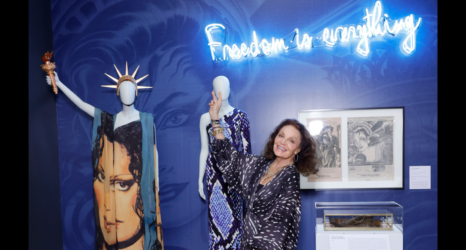The $20 bill is ubiquitous in U.S. currency. It’s what ATMs usually spit out at you, the cash you often have on hand when paying for groceries or movie tickets. Of course, when I’m tending to finances I can conveniently overlook the face that is currently stamped on it—seventh president Andrew Jackson, who was responsible for the Indian Removal Act—but the prospect of the face of Harriet Tubman peering back at me on a $20 bill has already filled me with glee and a sense of pride. (Tubman won an unofficial contest this week that asked participants to choose a new face for the $20 bill).
There is also, I must admit, a sense of irony. Although Tubman is widely known for her audacious anti-slavery role as conductor of the Underground Railroad—making 13 trips down South to free 70 enslaved peoples and then, during the Civil War, leading a military campaign at Combahee River that led to the liberation of 750 more slaves, some of whom were recruited for the Union Army—lesser known is the fact that she often dwelled in poverty. Dispossessed of material wealth while enslaved and severely injured as an adolescent, Tubman once described of herself: “They [slave buyers] wouldn’t give a sixpence for me.” Of course that all changed when she became notorious for aiding runaway slaves, a bounty on her head once rumored to reach the value of $20,000.
In freedom, her material struggles continued, but she strategically raised funds for the various fugitives who needed food, clothing and shelter, and in the latter years of her life, she focused on providing housing and healthcare for the sick and elderly, which eventually became the Harriet Tubman Home—still standing today in Auburn, New York. As a community-oriented leader, her vision for the Harriet Tubman Home eventually materialized before her death, but once it fell under management by the local AME Zion church, an admission fee was later added, much to her chagrin. Tubman believed that the home should be free and accessible for the aged and other people with disabilities. By the time Tubman became sick and poverty-stricken in her old age, funds had to be raised so that she could pay the admittance fee to her own home.
I imagine that the majority of votes cast to have Tubman on the $20 did so with the vision of Tubman the fearless conductor or Civil War hero, not Tubman the poverty-stricken elderly woman fighting for accessible healthcare for the most vulnerable community members. However, both images need to be etched into our consciousness as we continue to push for Tubman’s iconic face on the $20. Her existence on our currency would be a valuable reminder, not just of the will to freedom from capitalist-based exploitation of enslaved-bodies-turned-commodities, but also the will to community-building that emphasizes people over profits. As such, her face on the $20 would be the ultimate subversion of the “value” we place on money. We may need this constant reminder in light of the many calls that #BlackLivesMatter, including those of black women and transgender people.
The non-profit grassroots organization Women on the $20 galvanized support to put a woman on the $20 bill to mark the 100th anniversary in 2020 of the 19th amendment granting women the right to vote. Those who cared enough about the issue—around 600,000 to be specific—cast their votes online, and of the various women in history they voted for, Harriet Tubman rose to the top, beating out formidable First Lady Eleanor Roosevelt by 7,000 votes. Not to take away from any of the finalists in the competition, but Tubman was herself a women’s suffragist, throwing herself into the women’s rights cause especially when the U.S. government refused to grant her a veteran’s pension for her services as a Union army nurse, spy and scout because she was a woman. When her husband, fellow Civil War veteran Nelson Davis, died in 1888, Tubman had to apply for a widow’s pension. She didn’t get her own pension on her own veteran’s status until 1899, when she was already elderly and able to rely on numerous allies who campaigned for her rights to this pension—ironically, the pension she received was just $20 per month.
This country has a woefully dismal record of underpaying women—or not paying them at all!—and black women in particular are still viewed in terms of “cheap” or “free labor” potential. But just like Tubman’s allies in the 19th century, we 21st-century allies can keep pushing for her right to get paid (placement on our U.S. currency is a huge step to redress this). It certainly won’t substitute for the lack of reparations for slavery, but considering how this act relies on the power of the White House—now occupied by a man who stands tall on the shoulders of forebears like Tubman—it would help if we all joined together in campaigning for this action.
I look forward to Tubman replacing someone who instigated the Trail of Tears, or inserting her freedom-fighting presence among presidents, treasurers, founding fathers and slaveowners in history. I look forward to a night out spending my Harriets or donating to social justice causes she cared about, and doing so in memory of a woman who never had enough cash flow.
On the one hand, such commodification flies in the face of Tubman’s own impoverished experiences, not to mention the continued poverty that impacts the lives of so many black women today. As Kirsten West Savali argues, this push to place Tubman on the $20 is tantamount to “hush money” that hides our devaluation.
On the other hand, Tubman worked hard to get financial compensation for her labor. The U.S. government enlisted her services during the Civil War precisely because of the skills she acquired during her work on the Underground Railroad. That they denied her pay resulted in future generations knowing her name today. Had Tubman not been trying to raise funds denied to her, she may never have agreed to Sarah Bradford’s biography of her or of the subsequent writings and speeches that followed, galvanizing her heroic deeds. We wouldn’t have a name to vote for in the Women on the $20 campaign.
Harriet Tubman wanted to get paid then, and she deserves to be paid now. Getting paid in $20s is a start.
You may also like:





